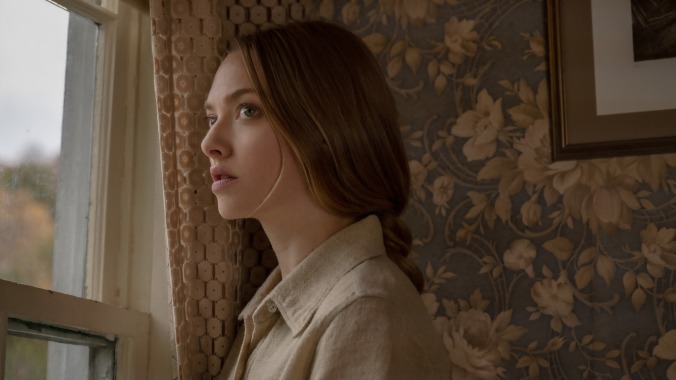Amanda Seyfried sifts through the gaslight of ghostly Netflix potboiler Things Heard And Seen


The murder mystery is a cousin to the ghost story. Both revolve around an untimely, tragic death; it’s just that one is more interested in the circumstances leading up to the murder, and the other its supernatural aftermath. Things Heard And Seen has both—although, of its competing terrors, the banal far overwhelms the uncanny. This is more of a “the husband did it” thriller with ghostly overtones than a horror film, and the restless spirits tend to show up when it’s thematically convenient rather than on some metaphysical timeline beyond mortal comprehension.
Things Heard And Seen is based on a novel, translated for the screen (and slightly renamed) by genre-hopping filmmakers Shari Springer Berman and Robert Pulcini (American Splendor). The result has the blunt faithfulness of a Lifetime Nora Roberts adaptation; whenever the camera turns toward, say, a horse or a bird, the assumption is that this was a rich symbol in the book, rather than the random cutaway it appears to be here. The early ’80s setting remains evocative, however, moving young intellectuals Catherine (Amanda Seyfried) and George (James Norton), along with daughter Franny (Ana Sophia Heger), from Manhattan to upstate New York—home of spiritualism, art colonies, and drafty old farmhouses—at the beginning of the film.
Playing housewife in one of those crumbling colonial relics, Catherine becomes convinced that she and Franny are not alone in the house when George goes off to teach art history at a liberal arts college during the day. They’re not, although the stone-faced, translucent woman occasionally spotted in the corner of a room isn’t the most immediate threat to Catherine’s safety. That would be George, whose sociopathy is first noted by the cynical young woman (Natalia Dyer) with whom he’s having an affair; it soon becomes obvious to his plainspoken colleague (Rhea Seehorn) and spiritualist boss (F. Murray Abraham), too. That’s where the murder comes in.
Gaslighting is a key theme in Things Heard And Seen—one of the signs that a spirit is near is literally the smell of gasoline—and Seyfried’s Catherine is an archetypical victim: fearful, isolated, and weakened by an eating disorder that’s dramatized throughout the film. Allen’s Mare tries to hip her to one of the consciousness-raising groups that were in vogue at the time, but ultimately the Feminine Mystique of it all overwhelms poor, neglected, college-educated Catherine, opening a portal that ties her soul to the generations of abused women who have lived in her house. (That, anyway, is what might be extrapolated from the film’s linear but still confusing structure.)
The setting for this overlong domestic drama is pretty, made up of misty fields and dignified lecture halls photographed by cinematographer Larry Smith, whose credits include Nicolas Winding Refn’s neon-soaked Only God Forgives. Like Smith, recent Oscar nominee Seyfried is a total professional, though she comes across just as stilted and unnatural as her costars. Playing a faithless liar with a frightening violent streak, Norton bears a superficial resemblance to It’s Always Sunny In Philadelphia’s Glenn Howerton—an unintentional inside joke that, combined with the tawdry infidelities and awful CGI effects, lends the film a made-for-TV quality. And it was made for TV, in a sense. Like many Netflix originals, Things Heard And Seen is the cinematic equivalent of a mass-market paperback, neither good enough to haunt the viewer nor bad enough to haunt the résumés of its cast and crew.